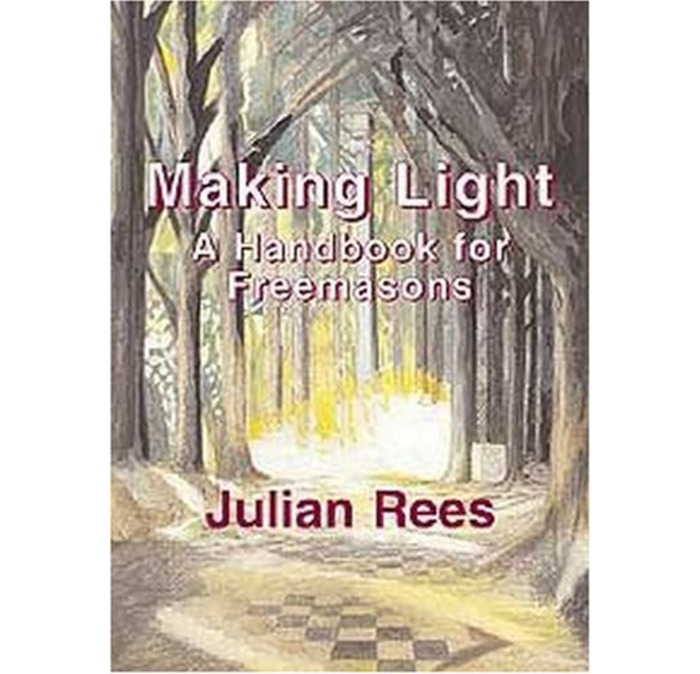Making Light: A Handbook for Freemasons
At last a well written easy to read step by step guide to the path of self knowledge and self improvement that is Freemasonry. This volume takes the reader through each of the three degrees of Craft Freemasonry, teaching him how best to gain insight from the study and application of these teachings. For the newly-made Mason this book provides an explanation of the ceremony he has just been through and an invaluable glossary of Masonic terminology to help him feel at home in the lodge. It also provides a similar guide for future degrees to help him understand and benefit from his future Masonic progression. For the Freemason of many years experience and knowledge, it will show him many interesting and largely unknown aspects of the symbolism of the three degrees and provide him with a resource to answer the enquiries of other brethren. To discover the true Masonic secret, we have to work to bring it forth; this book is the manual for that great work.
Reviews
From the Scottish Rite Journal
This is an interesting book, especially for an American reader. Its purpose, which it accomplishes admirably, is to give the new Entered Apprentice, Fellowcraft, or Master Mason an understanding of the degree he has received. It is clearly written, avoids jargon, and makes an impressive presentation.
For an American reader, one of the most interesting aspects are the differences in the ritual described in the book, and the ritual we are most familiar with in our own Lodges. The author does not point out those differences (it would badly interrupt the flow of the book if he did), but they become clear in the descriptions. For example:
"... the Tyler knocked on the door; that knock, given in your behalf...." In American Lodges, it is generally the Candidate who knocks for himself; the Tyler is usually in a different room.
"... you know that this Brother [who led you through the initiation] was the Junior Deacon." Here, of course, it is the Senior Deacon.
"... the Junior Deacon was to instruct you in the proper means of approaching the Master's pedestal." We would approach the altar.
There are many things like this which give an interesting insight into Masonic differences, while the lessons themselves show that similarities far outweigh the differences. It makes for an interesting read, which I greatly enjoyed.
Making Light - a Handbook for Freemasons
A short review
Freemasons throughout the centuries have conducted their craft ceremonies with great care and attention for what the words may mean to the new candidate. Yet whatever forethought is brought to bear by the officers of the lodge, it is almost inevitable that the candidate will need some simple and direct explanation regarding allegory and symbolism. There is of course no dogma; we are not told what to believe, only that the search for an explanation is one to which we should devote ourselves in the pursuit of knowledge, knowledge of ourselves and of our universe.
There has never been an adequate masonic primer until now, a publication into which the new-made mason may delve to find explanations and enlightenment. With the publication of this book by Julian Rees much has been achieved.
Divided into three chapters, each one dealing with one of the craft degrees, a simple journey is unfolded for us. Beginning with the first degree, we learn about the symbolism of how the Tyler prepares the candidate, of the inner significance of the deprivation of light, of the import of admission to the temple, of what is meant by 'mysteries' and 'privileges', of the significance of journeying and its similarity to pilgrimage, of the enormous significance of the restoration of light, and the importance of how we thereafter conduct ourselves towards God, towards ourselves, towards society and the state and towards freemasonry. We learn that, although certain aspects are kept private and not disclosed, yet the true secrets are those imparted to the heart and mind.
The second and third chapters are likewise full of hints illustrating allegories particular to the second and third degrees, of how we are to regard our journey through life, equipped with the responsibility we have been taught in the first degree, of how we are to address the acquisition of intellectual progress, progress of the heart as well as of the mind. Of how, in full possession of that responsibility we may face the severe tests that life often leads us through. Of how, regarding the finite nature of our physical life, we may best be prepared for eternity.
The language used by Rees is straightforward and uncomplicated. His assertions regarding what the ritual means are above controvery. Every new-made Apprentice, Fellow Craft or Master Mason will find here a true narrative of what the allegories are communicating, and will find comfort in a comprehensive understanding of what can sometimes be confusing. This book is thoroughly recommended and ought to be required reading as a follow-up to each of the degrees.
Each chapter is rounded off with a series of short test questions by which the candidate may test his new-found knowledge. Subjects covered include Jacob's Ladder, the nature of freedom, the Rule of Three, the dimensions of the lodge, from unenlightenment to enlightenment, obedience vis-à-vis responsibility, the temple of humanity, symbolic wages, the form of a winding staircase and its allegory, truth, uprightness and integrity, nature and science, parallel lines and pillars, birth, life and death, the need for mysteries to be hidden, personal darkness vis-à-vis general darkness, from matter to spirit, regeneration and transformation, location of the immortal principle, imports of the square pavement, departure from grace: approach to grace, different functions of the two legs of the compasses.



 Click on the image to enlarge
Click on the image to enlarge